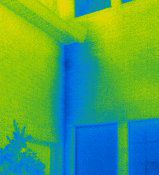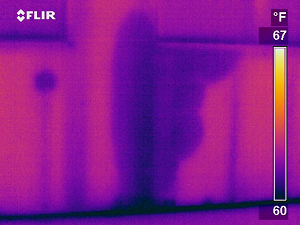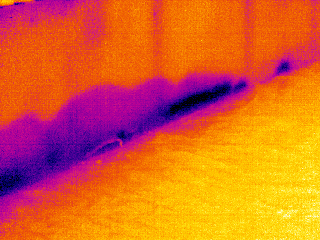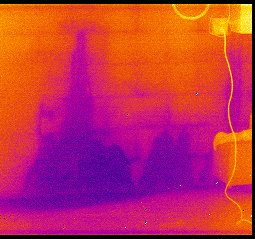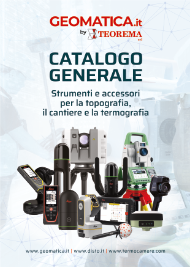|
termocamere.com
Il portale delle Termocamere "IR" per la Termografia e per l'Edilizia
Benvenuto! Accedi | Registrati
|
||||||
|
||||||
|
How To Detect a Water Leak with Thermal Imaging 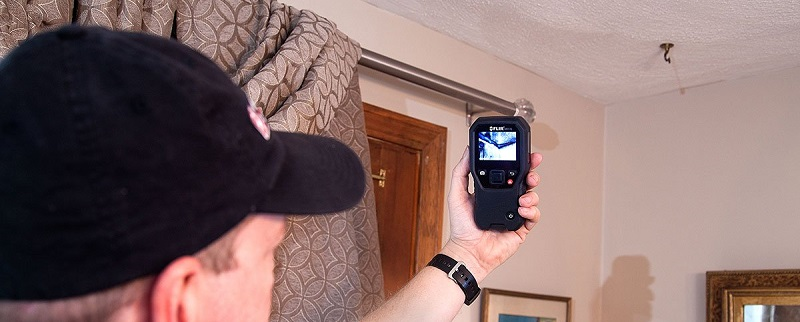 Water leaks and moisture infiltration can cause serious damage to a house or building, and can be difficult to detect until it’s already too late. Using a thermal imaging camera and under the right circumstances, it’s possible to find hidden water and moisture issues without resorting to destructive testing. There are many sources of building moisture, including humidity (during any season), condensation, pipe leaks, rain and snow, and even people and animals breathing. Usually a low level of moisture is fine, but leaks or heavy condensation can cause serious problems. A thermal imaging camera cannot “see” moisture in walls, but it can detect subtle temperature differences and patterns that reveal the existence of water. Moisture Patterns Moisture in buildings usually spreads in a recognizable pattern depending on where the water is: Walls - top-down triangular shape formed as water spreads downwards
Ceiling - amorphous, unstructured shape with areas of wet, damp, and moist material spreading outwards with different temperatures  Flooding - water wicking up a wall into the insulation and up wall studs
Hot Water Pipe - leaks shows as a warm area 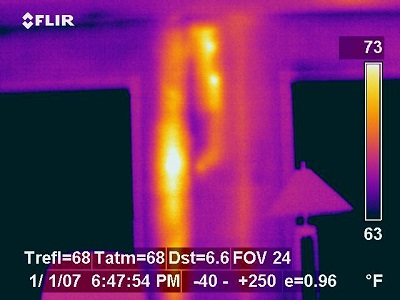 Moisture is one of the most difficult issues to detect in a building - the signs are subtle and easy to miss until water starts dripping from the ceiling. Thermography training can help with identification, as well as getting the right camera for the job. What’s the Best Thermal Camera For Moisture Detection? Moisture tends to cause only subtle heat differentials. A thermal camera capable of detecting moisture needs to have high resolution and great thermal sensitivity (NETD), meaning that small temperature differences will be displayed. In the case of thermal sensitivity, the lower the better, so a camera with 30mK sensitivity is great for moisture applications, while a 100mK sensitivity camera is better suited for industrial applications and detecting large temperature differences. In addition, it’s best to use a camera that allows you to manually adjust the level and span of the thermal image. Moisture problems appear best when the image is adjusted for about a 10°C or 20°C span, which helps even minute temperature differences stand out. Great thermal cameras for this purpose include the FLIR E6 for basic applications, and FLIR E8 and FLIR E95 for higher resolution options. Don’t Forget About Moisture Meters Thermal cameras can help locate water and approximate the moisture extent, but identifying a pattern that looks like moisture does not guarantee the presence of water. There are a multitude of reasons you might be seeing a temperature differential besides moisture in the walls. To check what you’re seeing, you should always use a moisture meter to confirm what the thermal camera has detected. Moisture meters from FLIR and Extech offer multiple detection options for every application, and meters like the FLIR MR176 even combine both thermal imaging and moisture measurement capabilities for both locating and testing for moisture. When performing a building inspection looking for water leaks, be sure to take your time. Water is detected with a thermal imager due to temperature differences caused by evaporation, capacitance, or conduction, and these processes can be affected by weather conditions or interior humidity. For a full understanding of how thermal imagers can detect moisture, consider taking a thermography course through the Infrared Training Center. |
||||||
|
TAG:
termocamere IR, termografia, umidità e temperatura, termocamera C3, TG165, Flir E54, Termocamera E5 wifi xt, Flir E8 xt, Termocamera E6 wifi xt, Flir T860, Flir T1020, Corsi termografia, termocamera flir c3, Flir C3, Termocamera E76, Termocamera E86, Termocamera E96, Thermal Imaging Flir, Distributore Ufficiale Flir, Official Flir Distributor.
|
||||||
|
|
||||||
|
© 2021 Teorema S.r.l. - P.I./C.F. 08379270153 - REA MI 1224723 - cap.soc. 100.000 € i.v. - Milano -
Condizioni di vendita -
Trattamento dei dati
Powered by Tecsia
|

